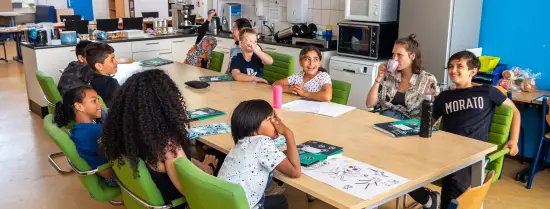
From favourite monsters to world-famous artists: children between the ages of 8 and 12 who have not been living in the Netherlands for long yet are doing their own research into these topics in the NIEUWsgierig project, organised by our university. "The lesson series aims to make the children wonder about the world and ask curious questions about it, which they can investigate with the help of EUR students," says organiser and EUR staff member Monique Herwegen.
Primary school Het Baken in Capelle aan den IJssel is one of the schools participating in NIEUWsgierig. EUR students Gao, Femke, Omar and Raechel are the teachers during the six lessons in Capelle. "You notice that the children really need it. In the beginning of each lesson, they are a bit shy. Later on, they loosen up, are cuddly and talk about their home situation. Apart from the fact that they really like the study, you also notice that they need more personal contact", says Raechel.

Monique is proud of the project: "Our university attaches great importance to equal opportunities in education. A language barrier among students can cause them to lag behind. That is why we think it is important to offer a project especially for these students, in which they can learn something they find really interesting and in which they get full attention."
Asking curious questions
11-year-old Adam comes from Morocco and has been living in the Netherlands for a year now. He is very happy every week when class starts again. "We learn especially to ask curious questions. These are questions that you cannot answer yes or no to," says Adam. "Very nice, because that way you get to know more about that subject."
The children also learn Dutch during the lessons, but that is not the main goal. According to organiser Monique, it is a nice bonus. "In a playful way, the pupils get to know the Dutch language and science. The focus is mainly on learning skills that are necessary in these times. We also want to show them that everyone, including them, has the opportunity to go to university later on. The children also learn the basics of scientific research."
''One of my pupils did research on paintings by world-famous artists. That's how she discovered for herself what the Mona Lisa is."
Doing research yourself
11-year-old Juan from South Africa has been living in the Netherlands since January. He compared the water quality in Capelle and Nesselande: "I looked at where the water is most liveable. I did that by taking water from a ditch in Capelle and from a ditch in Nesselande and looking at where the most aquatic animals live."
Student teacher Gao is glad she signed up for the project: "It's nice to see that the children learn new things. That they understand what they are doing in their research. One of my pupils did research on paintings by world-famous artists. That's how she discovered for herself what the Mona Lisa is."

Nine-year-old Sean comes from Curaçao and has been living in the Netherlands for two years. He has been researching samples. "I researched what the favourite monster is of everyone at school and whether they are afraid of monsters. I did this by means of a questionnaire. Many children think that Koekiemonster is the best monster there is."
Each week the children are also allowed to ask 'curious questions' about something they have encountered that week. 11-year-old Amar from Syria has been living in the Netherlands for three years now and finds this the most fun part of the lesson. "I wanted to know why some people have long hair and other people have short hair. Why doesn't everyone have short hair? Now I know that people with long hair never cut it and people with short hair don't let it grow."
''The great thing about this project is to see how happy the children become.''
Last lesson to present research
Every week the same student teachers are present. This ensures a familiar environment for learning as much as possible: "The great thing about this project is to see how happy the children become. With Sean it's monsters and with another student it's researching video games. They are busy with their favourite subject and they learn from it. You show that you can do research on anything."
During the last lesson, a market is organised at which the children present their research. Parents, grandparents and friends can come and watch. "I invite the children from my class. Hopefully they will like our research," says Sean.
Joining the NIEUWsgierig project for a day

- More information
Every year NIEUWsgierig is offered to a hundred children. The project is made possible by Wetenschapsknooppunt of Erasmus University Rotterdam. Discover here which other projects are being organised.


